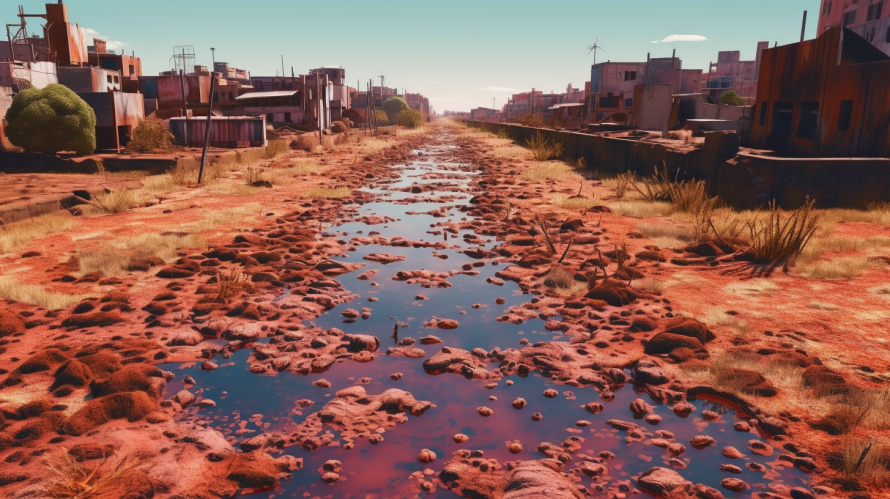
Drought is a natural disaster that affects many regions of the world, including South Africa. Meteorological drought is a type of drought that is defined on the basis of the degree of dryness and the duration of the dry period. The purpose of this article is to provide a detailed explanation of what is meteorological drought, how it relates to drought in South Africa, and the impact it has on the country.
Definition of Meteorological Drought
A meteorological drought is a type of drought that is defined by the amount of precipitation that falls in a region over a specific period of time. It is usually defined based on a comparison of the amount of precipitation received during the drought period to some “normal” or average amount of precipitation. This definition is region-specific as the atmospheric conditions that result in deficiencies of precipitation are highly variable from region to region.
Other Types of Drought
There are several types of droughts that can occur, depending on the region and the climate. The following are some of the types of droughts that are commonly observed besides meteorological drought:
- Hydrological Drought: This occurs when the water levels in rivers, lakes, and groundwater basins fall below the expected levels due to the lack of rainfall.
- Agricultural Drought: This occurs when the rainfall levels are insufficient to meet the water requirements of crops.
- Socioeconomic Drought: This occurs when the economic and social impacts of drought are felt by the local population.
Meteorological Drought in South Africa
South Africa is a country that is particularly susceptible to meteorological droughts due to its arid and semi-arid climate. The country experiences a wide range of meteorological droughts, ranging from mild to severe, depending on the region and the time of year.
The country is divided into different climatic regions, each with its unique weather patterns and rainfall regimes. The western part of the country experiences a Mediterranean-type climate, which is characterized by hot, dry summers and mild, wet winters. The central part of the country experiences a semi-arid climate, which is characterized by hot summers and cold winters, with most of the rainfall occurring during the summer months. The eastern part of the country experiences a subtropical climate, which is characterized by hot, humid summers and mild winters, with rainfall occurring throughout the year.
Impact of Meteorological Drought on South Africa
The impact of meteorological drought on South Africa is significant and can affect various aspects of the country’s economy and social well-being. Some of the impacts of meteorological drought on South Africa are as follows:
- Agriculture: Agriculture is the backbone of the South African economy, and meteorological droughts can have a devastating effect on the agricultural sector. Drought can lead to crop failure, reduced yields, and increased food prices, which can have a ripple effect on the entire economy.
- Water Resources: Drought can lead to a reduction in the water levels of rivers, dams, and groundwater basins. This can lead to water scarcity, which can affect both human consumption and industrial activities.
- Energy: Drought can also affect the production of hydroelectric power, which is a significant source of energy in South Africa. Reduction in the water levels of rivers and dams can lead to a reduction in the production of electricity, which can lead to load shedding and other energy-related problems.
- Livelihoods: Meteorological drought can have a severe impact on the livelihoods of people in South Africa, particularly those in rural areas. Farmers who rely on rainfall to irrigate their crops can suffer significant losses, which can lead to poverty and increased food insecurity.
- Biodiversity: Drought can also affect the natural ecosystems of South Africa. Reduced rainfall can lead to a reduction in the vegetation cover, which can affect biodiversity.
Cases of Meteorological Droughts in SA
While meteorological drought can occur in any part of the world, it is a common phenomenon in South Africa due to its geography and climate patterns. The country experiences an arid and semi-arid climate, characterized by low and highly variable rainfall. As a result, droughts are a frequent occurrence in various regions, with varying severity and impacts.
One of the most significant meteorological droughts in South Africa was the one that occurred between 2014 and 2016, which was considered the worst drought in the country’s history. The drought was caused by the El Niño Southern Oscillation (ENSO), a natural phenomenon that affects global weather patterns. The drought had a severe impact on the country’s agricultural sector, with crop production decreasing significantly, and livestock dying due to a lack of water and grazing land.
To monitor and predict droughts, the South African Weather Service (SAWS) has developed a system that measures and analyzes various meteorological variables such as rainfall, temperature, humidity, and wind speed. This system is used to issue early warnings to communities and authorities, allowing them to prepare for and mitigate the impacts of droughts.
Conclusion
In conclusion, meteorological drought is a type of drought that occurs due to a lack of precipitation in a specific region over an extended period. In South Africa, meteorological drought is a common occurrence due to its arid and semi-arid climate, with significant impacts on various sectors, including agriculture, water resources, and the economy. By monitoring and predicting droughts, it is possible to take proactive measures to reduce their impacts on communities and the environment.
